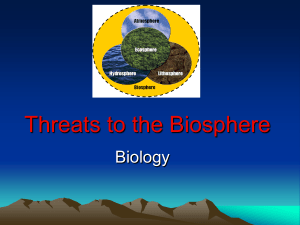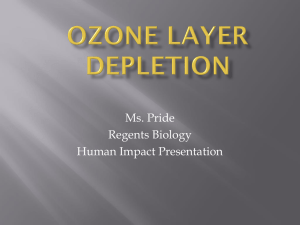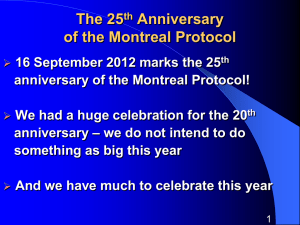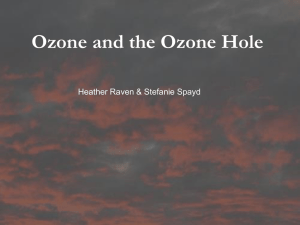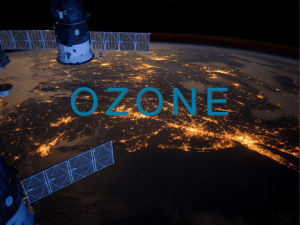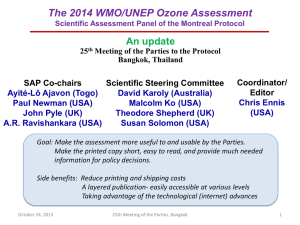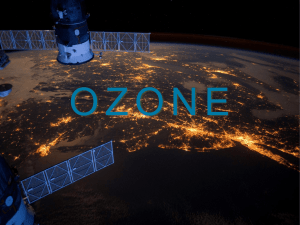Sustainability Options in Water Treatment - Trb
advertisement
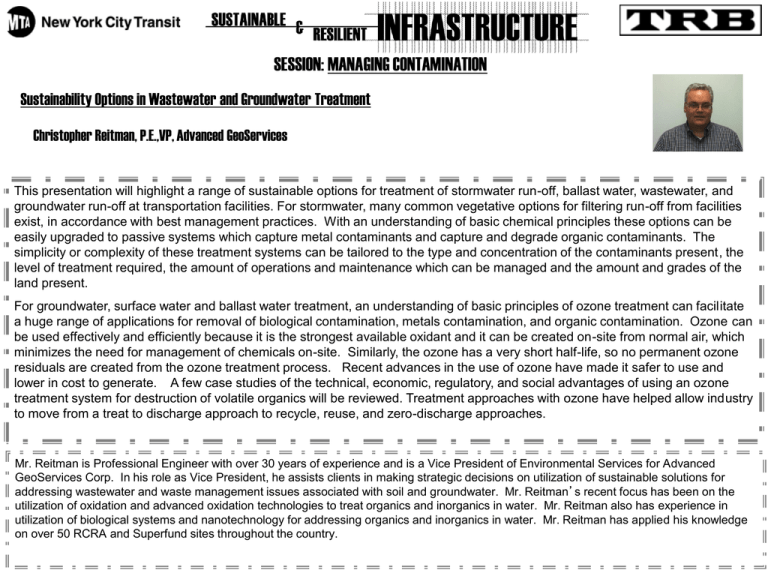
SESSION: MANAGING CONTAMINATION Sustainability Options in Wastewater and Groundwater Treatment Christopher Reitman, P.E.,VP, Advanced GeoServices This presentation will highlight a range of sustainable options for treatment of stormwater run-off, ballast water, wastewater, and groundwater run-off at transportation facilities. For stormwater, many common vegetative options for filtering run-off from facilities exist, in accordance with best management practices. With an understanding of basic chemical principles these options can be easily upgraded to passive systems which capture metal contaminants and capture and degrade organic contaminants. The simplicity or complexity of these treatment systems can be tailored to the type and concentration of the contaminants present, the level of treatment required, the amount of operations and maintenance which can be managed and the amount and grades of the land present. For groundwater, surface water and ballast water treatment, an understanding of basic principles of ozone treatment can facilitate a huge range of applications for removal of biological contamination, metals contamination, and organic contamination. Ozone can be used effectively and efficiently because it is the strongest available oxidant and it can be created on-site from normal air, which minimizes the need for management of chemicals on-site. Similarly, the ozone has a very short half-life, so no permanent ozone residuals are created from the ozone treatment process. Recent advances in the use of ozone have made it safer to use and lower in cost to generate. A few case studies of the technical, economic, regulatory, and social advantages of using an ozone treatment system for destruction of volatile organics will be reviewed. Treatment approaches with ozone have helped allow industry to move from a treat to discharge approach to recycle, reuse, and zero-discharge approaches. Mr. Reitman is Professional Engineer with over 30 years of experience and is a Vice President of Environmental Services for Advanced GeoServices Corp. In his role as Vice President, he assists clients in making strategic decisions on utilization of sustainable solutions for addressing wastewater and waste management issues associated with soil and groundwater. Mr. Reitman’s recent focus has been on the utilization of oxidation and advanced oxidation technologies to treat organics and inorganics in water. Mr. Reitman also has experience in utilization of biological systems and nanotechnology for addressing organics and inorganics in water. Mr. Reitman has applied his knowledge on over 50 RCRA and Superfund sites throughout the country. Sustainable Options For Water Treatment Christopher T. Reitman, P.E. 1055 Andrew Drive, Suite A West Chester, PA 19380 Tel: 610-840-9100, Fax: 610-840-9199 www.Advancedgeoservices.com creitman@advancedgeoservices.com 2 Presentation Overview • Introduce unconventional but sustainable and cost-effective options for water treatment at transportation facilities: – Ballast water, – Wastewater, – Groundwater, and – Run-off. • Review applications of ozone for sustainable treatment. 3 Typical Sustainability Goals/Drivers • Companies must meet reduced POTW/Effluent discharge guidelines/standards • Must be economical • Must treat more recalcitrant compounds Conventional BioRetention Systems • T Typical Bioretention System Not typically engineered to be contaminant specific and or to meet contaminant specific discharge standards 5 PASSIVE BIOTREATMENT APPROACH Engineered to meet specific discharge goals which are often contaminant specific Settling Pond 1 Aerobic • • • • 2 Aerobic Cell Type – Aerobic Ammonia Nitrification Aerobic Carbon Biodegradation Metals Precipitation (Carbonates, Oxides, Hydroxides) BOD/COD Reduction 3 4 Aerobic Anaerobic Anaerobic • Dentrification to N2 • Dechlorination of Organics • Metals Precipitation Basin • Aeration • Settling NPDES Discharge Existing Passive BioTreatment Applications • • • • • • • • • • • Airport – Glycol Treatment Domestic Sanitary Sewage Winery Wash Water Greenhouse Leachate Landfill Leachate Slaughterhouse Wastewater Mushroom Farm leachate Bakery Process Water Liquid Swine Manure Mining Waste for Metals (bioreactors) Many, many other applications Most things that can be treated with conventional systems can be treated with Passive Biotreatment systems 7 Contaminant Specific Treatment Well Known Treatment Profiles Exist For Most Elements/Compounds Oxidizing Aerobic Anaerobic 8 Design Process • Understand matrix being treated, volume of contaminants and discharge goals • Choose an appropriate substrate and system • Utilize column studies and pilot scale studies to verify applicability • Step-wise process to demonstrate proof of concept and applicability to each water type • Plantings often incorporated into the treatment process 9 Substrate Selection Considerations • • • • • • • • Availability Economics Suitability for Treatment Start-up Rate vs. Longevity Buffering Capability Start-up Color Tolerance Particle size Permeability Typical Treatment Substrates Sawdust ALFALFA HAY SAWDUST CORN WASTE Soil Soil MUSHROOM COMPOST COW MANURE WOOD CHIPS BREWERY WASTE Ref: Hagerty Example 1 - Glycol Treatment for Aircraft Deicing Heavy snow loads in winter Airfield operations are heavily dependent on effective deicing operations. Ref: Wallace, et al 12 Aircraft Deicing • Deicing fluids include ethylene glycol (EG), propylene glycol (PG) and diethylene glycol (DEG) • Runoff can contain over 20,000 mg/L at 1oC • New environmental regulations are requiring treatment of deicing runoff. • Major challenge for conventional treatment plants. • Systems constructed at both Heathrow and Buffalo airport 13 Design Considerations • • • • • Design COD Load System Loading Available Area Bed volume Understand Aeration Requirements for Degradation in warm and cold conditions 14 Review Available Treatment Options • Anaerobic Digestion (biogas) – Shock loadings, limited net biogas • Mechanical Treatment (activated sludge, MBRs) – Shock loadings, energy intensive • Discharge to Regional Sewer – Long-term concerns over cost and capacity • Passive (ponds and open-water wetlands) – Land intensive • Biotreatment with Wetlands – No water exposed, land intensive 15 Complete Treatability Testing • Measure glycol degradation in both warm and cold temperatures • With and without aeration Ref: Wallace, et al 16 Construct System Ref: Wallace, et al 17 Buffalo Airport Deicing Fluid Treatment 2010-2011 18,000 16,000 Calculated CBOD5 (mg/L) 14,000 Influent CBOD5/TOC: 2.25 Effluent CBOD5/TOC: 0.45 Based on Stantec's Engineered Wetland Treatment System BNIA Calibration of TOC Meters Report (6/4/2010) Influent 12,000 10,000 8,000 6,000 Effluent 4,000 2,000 0 10/29/2010 11/18/2010 12/8/2010 12/28/2010 1/17/2011 2/6/2011 2/26/2011 3/18/2011 4/7/2011 4/27/2011 Ref: Wallace, et al 18 Example 2 – Zinc and Lead Removal Ref: Gusek, Wilderman, et al 19 Typical Treatment Cell Construction Activities Mixing Substrate Ref: Blumenstein, et al. Placement of Substrate 20 Final Site Conditions Take Home Points on Passive Treatment • Applicable to both organics and metals • Treatability Testing is key for scale-up from column, bench, pilot and full scale (Part Art – Part Science) • Very consistent performance available from full scale systems. • Land must be available for implementation • Can be very cost-effective • Not walk away systems -require some maintenance 22 Ozone – Another Sustainable Technology 23 How is Ozone (O3) Produced? It only takes a spark Ozone Formation from Lightening Ozone is responsible for the "fresh air" smell after a lighting or thunder storm. An electrical discharge (a spark) splits an oxygen molecule into two oxygen atoms. These unstable oxygen atoms combine with other oxygen molecules. This combination forms ozone. Ref: Leusink 24 How Long Does it Last? Ozone Dissolved in Water (ph-7) Half-life Temp (C) 15 30 minutes 20 20 minutes 25 15 minutes 30 12 minutes 35 8 minutes 13X as soluble as oxygen Does Not Last Very Long In Water! Ref:Leusink 25 How Strong Is It? Oxidation Potential Oxidant Electrochemical Potential (volts) Free Radical, -OH 2.80 Ozone, O3 2.07 Hydrogen Peroxide, H2 O2 1.78 Potassium Permanganate, KMnO4 1.70 Chlorine Dioxide, ClO2 1.57 Hypochlorous Acid, HOCl 1.49 Chlorine gas, Cl2 1.36 Oxygen (molecular), O2 1.23 Bromine 1.09 Sodium Hypochlorite, NaOCl 0.94 Iodine 0.54 26 Ozone History – Is it Safe? 1785 Strange odor was recognized by Van Murum Presented to academy of Munich in 1840 Connected smell from electrolysis, sparking and lightening Named ozone after greek word ozein meaning “to smell” 1840 1857 First industrial ozone generator – Werner von Siemens 1866 Identified molecular structure O3 – Jacques-Louis Soret 1893 First full-scale drinking water application – Oudshoorn, Netherlands 1897 First ozone company, Compagnie Generale de l'Ozone – Marius Paul Otto 1903 First US drinking water installation – Niagara Falls, New York 1906 Oldest continuously operating drinking water installation – Nice, France 1909 Ozone used as a preservative for cold storage of meats – Koln, Germany 1933 Research performed on the effect of ozone on banana ripening - Gane 1936 Research on ozone as an antimicrobial agent performed - Klotz 1940 Oldest continuously operating US drinking water installation – Whiting, IN 1982 FDA GRAS declaration for ozone use in bottled water applications 1996 Japan and Australia approve ozone use for foods 1997 EPRI petitions to achieve GRAS approval for ozone use on food products 2001 Final rule granting GRAS approval for ozone use in direct contact with food 27 Key Advantages of Ozone Strongest disinfectant/oxidizing agent available Adds no chemicals (no chemical storage) Unstable - Leaves no residual (reverts to oxygen) Provides flexibility to adjust to a wide range of flows and concentrations Can be combined with peroxide or UV for even higher strength (Advanced Oxidation Processes – AOP) 28 Where is Ozone Used? Water Treatment Disinfection Control of algae Oxidation of inorganic and organic compounds Air Treatment Odor reduction and control Control of yeast and mold spores Aquariums and Aquaculture Industrial Paper production – pulp bleaching Cooling tower biocide Semiconductor production Food Surface sanitation Food storage, extend shelf life(cold storage) Direct contact (produce washing with ozonated water) Laundry Medicine 29 Water Treatment - Groundwater Groundwater Remediation Pump and Treat In-Situ and ex-situ Remediation Common contaminates BTEX MTBE TBA Chlorinated Solvents Any other compound broken down by chemical oxidation 30 Typical System Components • • • • • Air Source Dryer O2 Concentrator Ozone Generator Air-Water Contactor 31 Conclusions • Many creative ways to implement sustainable solutions in water treatment • Passive Biotreatment and Active Oxidative Solutions both may be part of Green Sustainable Solutions if you understand the applications and the benefits 32 Reference List 1) 2) 3) 4) 5) 6) 7) Scott Wallace, Mark Liner, David Cooper, Clodagh Murphy, Russell Knight, Glycol Treatment for Aircraft Deicing, Power Point. Gusek James J., Periodic Table of Passive Treatment, ASMR Conference, 2009, Paul Hagerty, Linda Figueroa, Ph.D., James Fricke, Organic Substrate Selection Considerations for Containment Specific Treatment Using Bio infiltrating Systems, Powerpoint Paul Hagerty, Linda Figueroa, Ph.D., James Fricke, The Effect of Particle Size on Sulfate Reduction Efficiency on Mining Influenced Water, Powerpoint Joel Leusink, Ozone Solutions, Understanding Ozone, Powerpoint James Gusek, P.E., Dr. Thomas Wildeman, Aaron Miller, and James Fricke, The Challenges of Designing, Permitting, and Building a 1,200 GPM Passive Bioreactor for Metals Drainage, West Fork mine, Missouri. E.P. Blumenstein and J,.J. Gusek, Designing a Biochemical Reactor for Selenium and Thallium Removal from Bench Scale Testing through Pilot Construction


